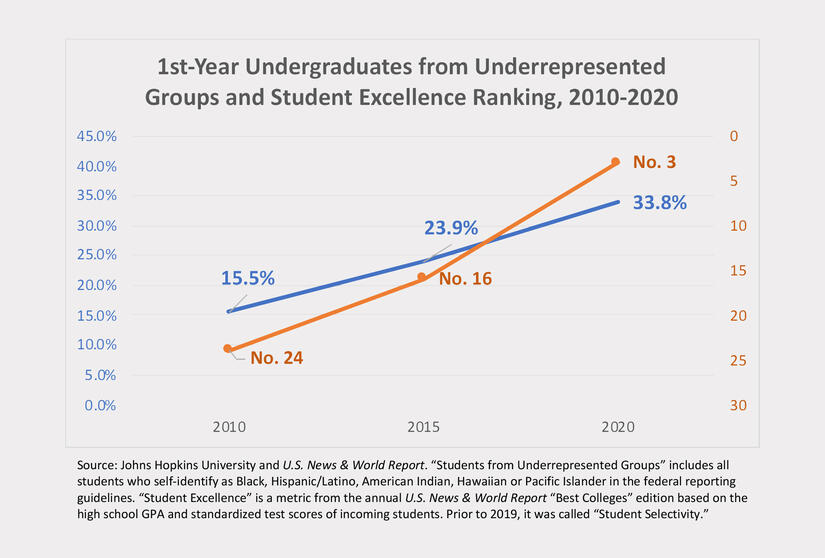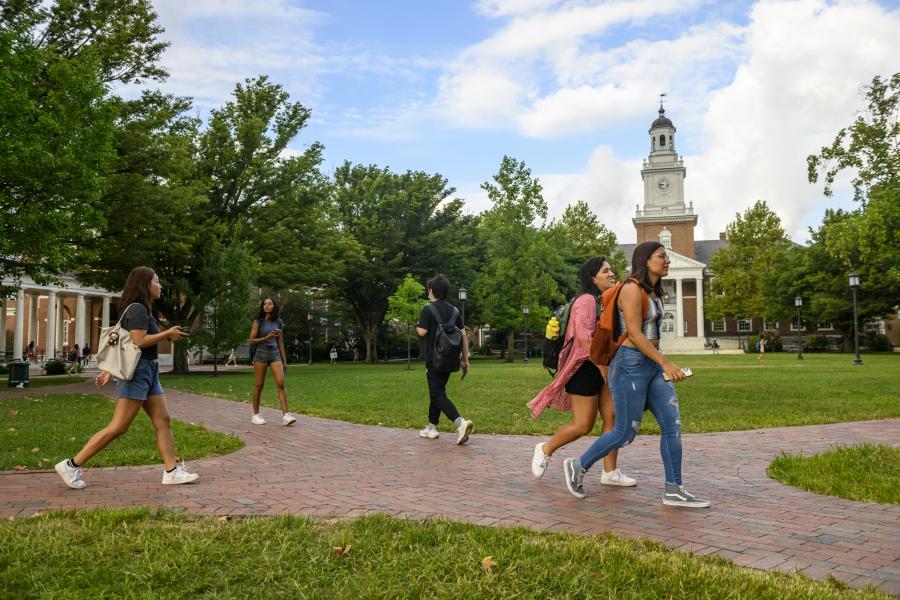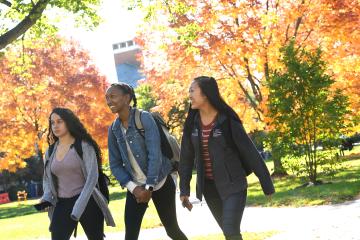- Name
- Johns Hopkins Media Relations
- jhunews@jhu.edu
- Office phone
- 443-997-9009
This fall, Johns Hopkins University welcomed its first class of incoming first-year undergraduates since the U.S. Supreme Court's 2023 decision to restrict the use of race in admissions. The Class of 2028 continues to reflect the strong academic qualifications of recently admitted classes, along with high levels of socioeconomic diversity. But for the first time in many years, the percentage of students from underrepresented groups dropped significantly.
Comparison to recent years
The incoming class increased on measures of socioeconomic diversity. The percentage of students from low-income backgrounds, measured by eligibility for federal Pell grants, rose to 23.8%, Hopkins' highest percentage to date. The percentage of first-generation college students rose from 19.4% to 20.3%. The percentage of students who are first-generation or low-income is 30.2%. These changes reflect the university's long-term efforts to attract the country's best students regardless of means, bolstered by the transformative $1.8 billion gift for undergraduate financial aid from philanthropist, business leader, and Johns Hopkins alumnus Michael R. Bloomberg in 2018.
Academic qualifications, measured by standardized test scores and high school grade point average (GPA), remained consistent with those of recent years, when Hopkins has admitted some of the most academically qualified classes in the country.
The percentage of students reporting identities from underrepresented groups, however, fell to 17.6%. The percentage was 37% for the class that entered last fall. The percentage of students who did not report race or ethnicity rose from 1.6% to 3.0%. (More on the data, which accounts for students who report more than one race and ethnicity, is available on the Office of Institutional Research website.)
"Last summer, when the Supreme Court issued its decision to restrict the use of race and ethnicity in college admissions, we shared our concerns that the change would be a significant setback in the progress we have made in building a university community that represents the extraordinary diversity of talented students across America," JHU President Ron Daniels and Provost Ray Jayawardhana wrote in a message to the university community today. "The impact of the ruling on racial and ethnic diversity in this admissions cycle is profoundly disappointing."
Prior to the Supreme Court decision, Johns Hopkins experienced steady growth in levels of underrepresented students. From 2010 to 2020, the percentage of first-year students self-reporting identities from underrepresented groups rose steadily from 15.5% of the class to 33.8%.
The growth in racial and ethnic diversity coincided with a rise in the academic qualifications of enrolled students. Since 2019, Hopkins has consistently admitted one of the top three most academically qualified classes in the country, according to data on test scores and high school GPA collected by U.S. News & World Report.
Peer institutions across the country are reporting declines this fall. The decrease at Hopkins is comparable to changes in the 1990s and 2000s in states that ended the use of race in admissions. In California (1996) and Michigan (2006), the percentage of incoming students from underrepresented groups fell significantly at flagship universities, only to recover slowly over time.
Moving forward
"Hopkins has a successful track record of increasing diversity over the previous decade. We must build on that experience now as we look to the future," said David Phillips, vice provost for admissions and financial aid. "Moving forward, we will continue to scrupulously comply with the law while exploring race-neutral strategies to build a university community that resembles the rich diversity of America."
These strategies will include redoubling recruiting efforts that have been successful in the past, such as the university's outreach to majority-minority high schools and collaborations with community-based organizations; exploring race-neutral tools to evaluate an applicant's environmental context, such as the College Board's Landscape tool; doing more to recruit high-achieving students from rural and urban communities; leveraging standardized testing to identify students who may have significantly outperformed relative to their high school; and making sure that high-achieving applicants of all backgrounds are aware of the incredible levels of financial aid available to undergraduates at Hopkins.

Prior to the court's decision, Hopkins had for many years vigorously supported the limited use of race and ethnicity as part of a holistic admissions process. The university joined amicus briefs supporting this position in the major cases before the court.
"We seek diversity in many forms—socioeconomic background, geography, viewpoint, religion, race, and ethnicity," Phillips said. "We believe that cultivating a diverse community is indispensable to our educational mission. Experiencing diversity helps students of all backgrounds learn to question their assumptions, test received truths, and become leaders who can succeed in a complex, modern world."
"Our commitment to building and supporting a diverse class is unwavering," Daniels and Jayawardhana wrote. "We are thrilled and honored to have each and every one of our extraordinary students here as part of our community. And we will continue to do everything in our power to open wide the doors of opportunity to our nation's most promising students."
Posted in University News









